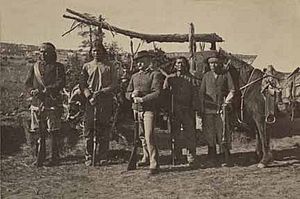Navajo Scouts facts for kids
Quick facts for kids Navajo Scouts |
|
|---|---|

Navajo scouts and a cavalryman at Fort Wingate, c.1890.
|
|
| Active | 1873 - 1895 |
| Country | |
| Branch | |
| Type | Indian scouts |
| Engagements | Chiricahua Wars Geronimo's War |
| Commanders | |
| Notable commanders |
George Crook Nelson A. Miles |
The Navajo Scouts were a special group of Native Americans who worked with the United States Army from 1873 to 1895. They were part of a larger program called the United States Army Indian Scouts.
These scouts usually joined the army at Fort Wingate in New Mexico. Their service periods often lasted for six months. Between 1873 and 1885, there were typically 10 to 25 Navajo scouts working with different army units.
During the important Geronimo Campaign in 1886, about 150 Navajo scouts were involved. They were divided into three groups. These scouts were part of a much larger force of 5,000 soldiers led by General Nelson A. Miles. By 1891, scouts began serving for three-year periods. In 1895, the Navajo scouts became a regular part of the army. Some individuals served as scouts for more than 25 years.
Contents
Between 300 and 400 Navajo people served as scouts for the U.S. Army. Most of these scouts came from the southeastern part of the Navajo reservation. Many of them joined the army multiple times.
After the difficult period known as the Long Walk of the Navajo, the army started to work with Navajo people. In April 1871, Major William Redwood Price allowed 15 Navajo men to travel with him. This trip was from Fort Wingate to Fort Apache. However, these men were not officially "scouts" yet.
In January 1873, the army officially allowed 50 Indian Scouts to be hired in the New Mexico Territory. Major Price hired at least 25 Navajo men for this first group of scouts at Fort Wingate. They were very active until their service ended in August 1873.
Many of the scouts came from areas near the Navajo reservation. Some Navajo people said that a leader named Mariano (also known as Hastiin Łitsotsʼósí) told them they had to become scouts or move away from their homes. Because of this, many agreed to join.
In 1876, Lieutenant Colonel P. T. Swaine reported that Chief Mariano helped get the latest group of scouts. In 1877, Lieutenant Henry Wright of the 9th Cavalry hired 21 young, strong, and well-mounted Navajo men. The army continued to employ Navajo people as scouts until 1895.
The Navajo scouts based at Fort Wingate played a key role in fighting against Victorio's Apache warriors. This fighting took place from 1876 to 1880. They were involved in battles in the Florida Mountains of New Mexico in 1877. They also fought at Las Animas Creek in 1879.
Lieutenant Henry Wright and Scout Jose Chavez were praised for their bravery in a battle in 1877. Jose Chavez was still serving in the army at Fort Wingate in 1891. Generals like George Crook and Nelson A. Miles used Navajo scouts to find Apache leaders such as Juh, Nana, and Geronimo between 1881 and 1886. In 1886, General Miles used 150 Navajo scouts in his large force against Geronimo.
Helping with Conflicts
Navajo scouts also helped the U.S. Army when there were problems between civilians and Navajo people. For example, between June and September 1883, there were five different situations involving the Navajo reservation.
- Lieutenant Parker, with 10 soldiers and two scouts, went to the San Juan River. Their job was to separate Navajo people from settlers who were moving onto Navajo land.
- Lieutenant Guy, with 17 soldiers and two scouts, and Captain Smith, with 56 soldiers and five scouts, helped the local Indian agent. They dealt with unhappy Navajo chiefs like Manuelito, Torlino, and Grando Muncho. These chiefs and 50 armed Navajo people were upset because other tribes and settlers were raiding their people and stealing their livestock.
- In another event, Lieutenant Lockett and Lieutenant Holomon joined forces at Navajo Springs. A settler named Houck or Owens had murdered a Navajo chief's son. About 100 armed Navajo people were looking for them.
Military reports from this time show that army officers often trusted the Navajo version of events.
In 1891, Navajo scouts worked with the army when over 60 armed Hopi people were ready to fight. They did not want their children to be sent away to boarding school. An army officer wrote in 1891 that he had known Navajo people since 1853. He had even commanded 50 Navajo men in Benjamin Bonneville's 1857 trip against the Apaches. He had complete trust in their friendship.
"After coming back from Fort Sumner to Fort Wingate some of our people became scouts for the military police or the Army. The Chishi Dine'e (Chiricahua Apaches) got in trouble with the Army, and the Navajo scouts fought with the Army. The Navajos helped in that way. Many of our people have told about this helping the Army, and some passed away still saying it."
In the late 1920s, scouts became eligible to receive pensions. Many of these men had joined the army using nicknames. They had also lost their discharge papers, which proved their service. To get their pensions, these men gave official statements about their time as scouts. They also vouched for other scouts. This happened between the late 1920s and early 1940s.

